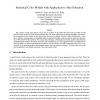Free Online Productivity Tools
i2Speak
i2Symbol
i2OCR
iTex2Img
iWeb2Print
iWeb2Shot
i2Type
iPdf2Split
iPdf2Merge
i2Bopomofo
i2Arabic
i2Style
i2Image
i2PDF
iLatex2Rtf
Sci2ools
CVPR
1999
IEEE
1999
IEEE
Statistical Color Models with Application to Skin Detection
The existence of large image datasets such as the set of photos on the World Wide Web make it possible to build powerful generic models for low-level image attributes like color using simple histogram learning techniques. We describe the construction of color models for skin and non-skin classes from a dataset of nearly 1 billion labelled pixels. These classes exhibit a surprising degree of separability which we exploit by building a skin pixel detector achieving a detection rate of 80% with 8.5% false positives. We compare the performance of histogram and mixture models in skin detection and find histogram models to be superior in accuracy and computational cost. Using aggregate features computed from the skin pixel detector we build a surprisingly effective detector for naked people. Our results suggest that color can be a more powerful cue for detecting people in unconstrained imagery than was previously suspected. We believe this work is the most comprehensive and detailed explora...
Computer Vision | CVPR 1999 | Histogram Learning Techniques | Histogram Models | Powerful Generic Models | Skin Color Models | Skin Pixel Detector |
| Added | 12 Oct 2009 |
| Updated | 12 Oct 2009 |
| Type | Conference |
| Year | 1999 |
| Where | CVPR |
| Authors | Michael J. Jones, James M. Rehg |
Comments (0)

